In-Depth Accounting Financial Analysis Report of Electricity Firms
VerifiedAdded on 2023/06/15
|9
|2014
|497
Report
AI Summary
This report provides an in-depth financial analysis of St Lucia Electricity Services and Dominica Electricity, focusing on key financial ratios such as liquidity, profitability, capital structure, and market performance. It includes a comparative analysis of these ratios, along with share and bond evaluations. The report computes current ratios, return on equity, debt ratios, and price-earnings ratios to assess the financial health and investment potential of both companies. The share evaluation calculates the market value of shares based on dividend payments and growth rates, while the bond evaluation determines the price at which bonds will trade in the market. The analysis concludes that Dominica Electricity demonstrates a higher return on equity, making it a potentially more attractive investment for shareholders.
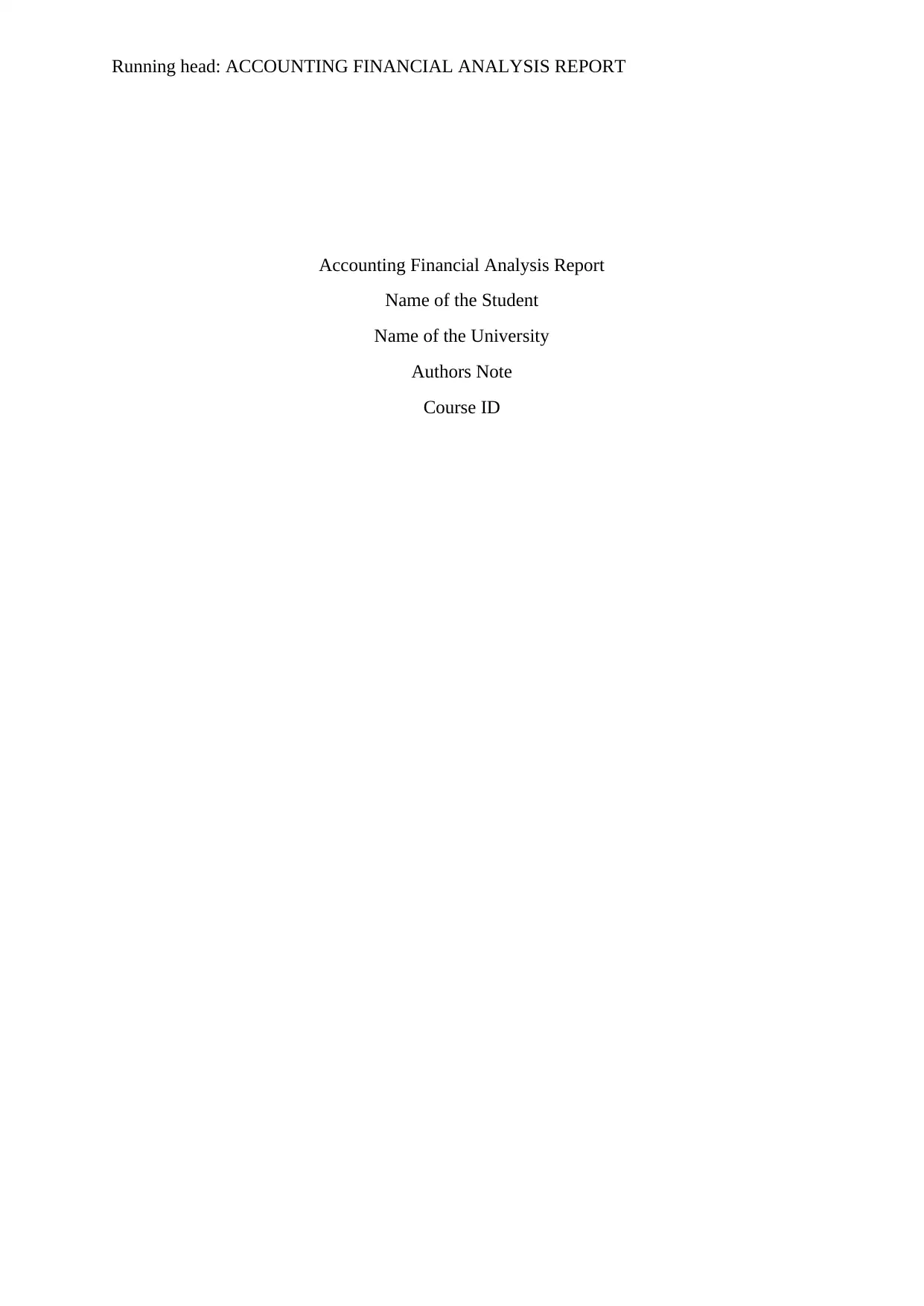
Running head: ACCOUNTING FINANCIAL ANALYSIS REPORT
Accounting Financial Analysis Report
Name of the Student
Name of the University
Authors Note
Course ID
Accounting Financial Analysis Report
Name of the Student
Name of the University
Authors Note
Course ID
Paraphrase This Document
Need a fresh take? Get an instant paraphrase of this document with our AI Paraphraser
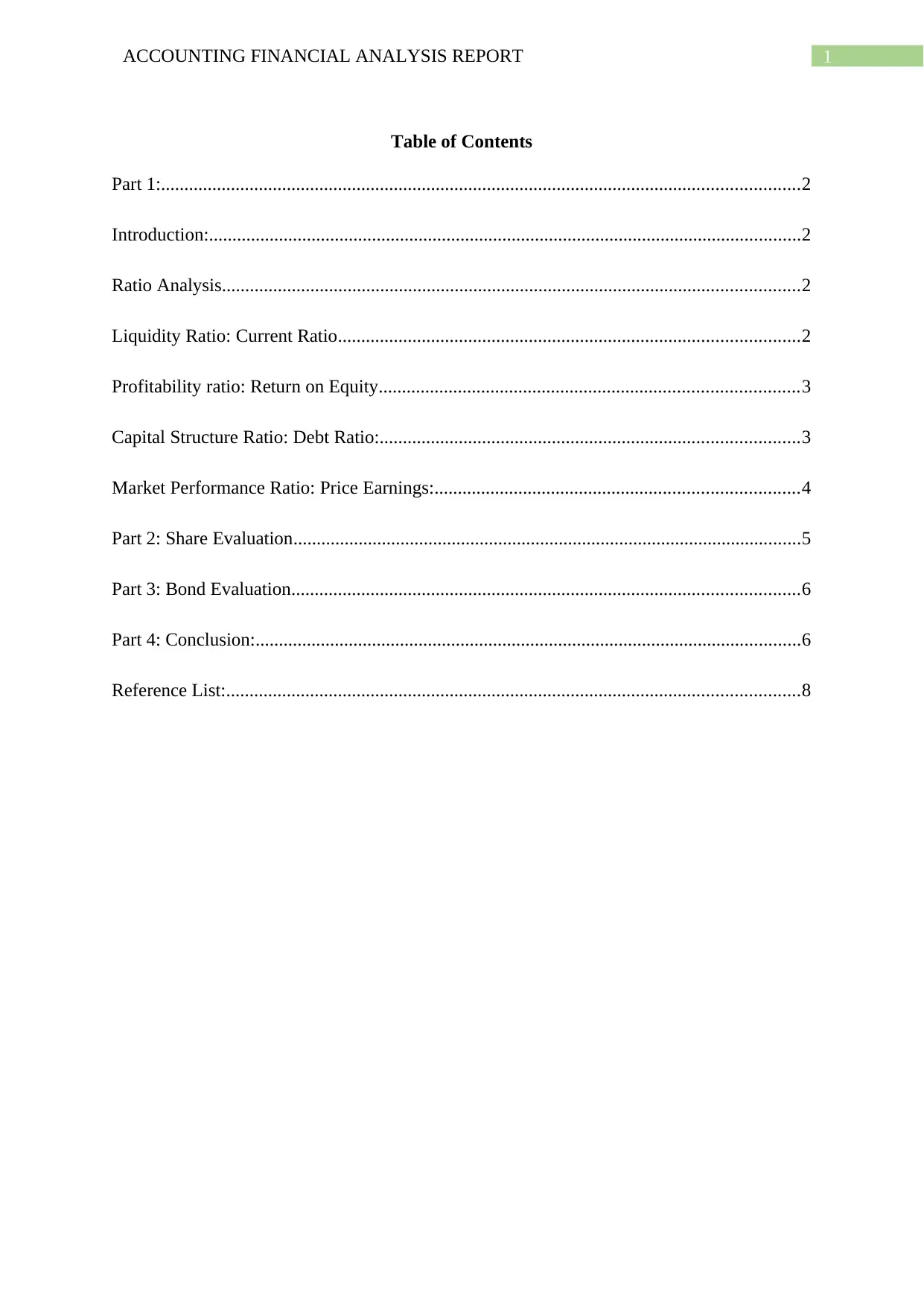
1ACCOUNTING FINANCIAL ANALYSIS REPORT
Table of Contents
Part 1:.........................................................................................................................................2
Introduction:...............................................................................................................................2
Ratio Analysis............................................................................................................................2
Liquidity Ratio: Current Ratio...................................................................................................2
Profitability ratio: Return on Equity..........................................................................................3
Capital Structure Ratio: Debt Ratio:..........................................................................................3
Market Performance Ratio: Price Earnings:..............................................................................4
Part 2: Share Evaluation.............................................................................................................5
Part 3: Bond Evaluation.............................................................................................................6
Part 4: Conclusion:.....................................................................................................................6
Reference List:...........................................................................................................................8
Table of Contents
Part 1:.........................................................................................................................................2
Introduction:...............................................................................................................................2
Ratio Analysis............................................................................................................................2
Liquidity Ratio: Current Ratio...................................................................................................2
Profitability ratio: Return on Equity..........................................................................................3
Capital Structure Ratio: Debt Ratio:..........................................................................................3
Market Performance Ratio: Price Earnings:..............................................................................4
Part 2: Share Evaluation.............................................................................................................5
Part 3: Bond Evaluation.............................................................................................................6
Part 4: Conclusion:.....................................................................................................................6
Reference List:...........................................................................................................................8
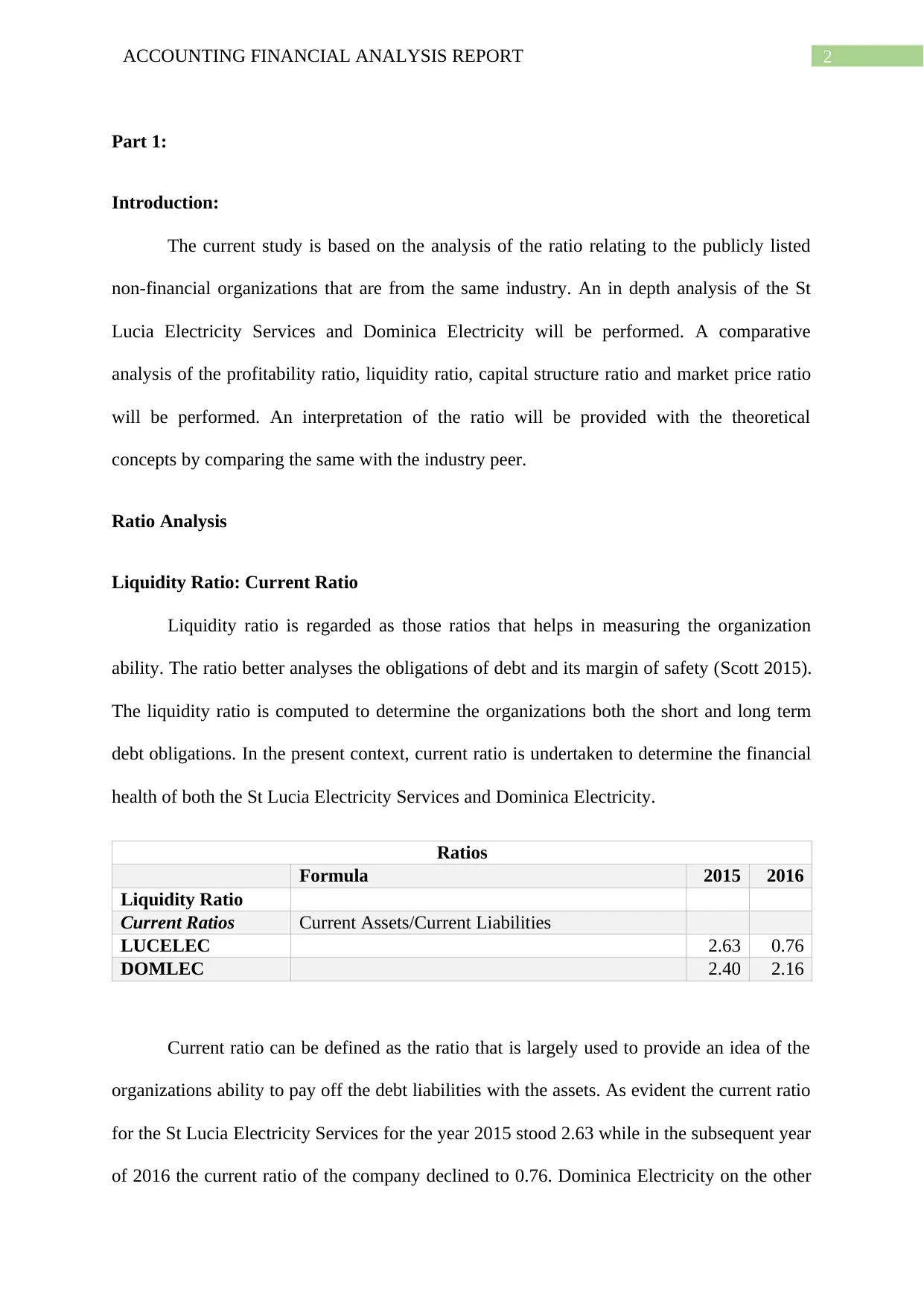
2ACCOUNTING FINANCIAL ANALYSIS REPORT
Part 1:
Introduction:
The current study is based on the analysis of the ratio relating to the publicly listed
non-financial organizations that are from the same industry. An in depth analysis of the St
Lucia Electricity Services and Dominica Electricity will be performed. A comparative
analysis of the profitability ratio, liquidity ratio, capital structure ratio and market price ratio
will be performed. An interpretation of the ratio will be provided with the theoretical
concepts by comparing the same with the industry peer.
Ratio Analysis
Liquidity Ratio: Current Ratio
Liquidity ratio is regarded as those ratios that helps in measuring the organization
ability. The ratio better analyses the obligations of debt and its margin of safety (Scott 2015).
The liquidity ratio is computed to determine the organizations both the short and long term
debt obligations. In the present context, current ratio is undertaken to determine the financial
health of both the St Lucia Electricity Services and Dominica Electricity.
Ratios
Formula 2015 2016
Liquidity Ratio
Current Ratios Current Assets/Current Liabilities
LUCELEC 2.63 0.76
DOMLEC 2.40 2.16
Current ratio can be defined as the ratio that is largely used to provide an idea of the
organizations ability to pay off the debt liabilities with the assets. As evident the current ratio
for the St Lucia Electricity Services for the year 2015 stood 2.63 while in the subsequent year
of 2016 the current ratio of the company declined to 0.76. Dominica Electricity on the other
Part 1:
Introduction:
The current study is based on the analysis of the ratio relating to the publicly listed
non-financial organizations that are from the same industry. An in depth analysis of the St
Lucia Electricity Services and Dominica Electricity will be performed. A comparative
analysis of the profitability ratio, liquidity ratio, capital structure ratio and market price ratio
will be performed. An interpretation of the ratio will be provided with the theoretical
concepts by comparing the same with the industry peer.
Ratio Analysis
Liquidity Ratio: Current Ratio
Liquidity ratio is regarded as those ratios that helps in measuring the organization
ability. The ratio better analyses the obligations of debt and its margin of safety (Scott 2015).
The liquidity ratio is computed to determine the organizations both the short and long term
debt obligations. In the present context, current ratio is undertaken to determine the financial
health of both the St Lucia Electricity Services and Dominica Electricity.
Ratios
Formula 2015 2016
Liquidity Ratio
Current Ratios Current Assets/Current Liabilities
LUCELEC 2.63 0.76
DOMLEC 2.40 2.16
Current ratio can be defined as the ratio that is largely used to provide an idea of the
organizations ability to pay off the debt liabilities with the assets. As evident the current ratio
for the St Lucia Electricity Services for the year 2015 stood 2.63 while in the subsequent year
of 2016 the current ratio of the company declined to 0.76. Dominica Electricity on the other
⊘ This is a preview!⊘
Do you want full access?
Subscribe today to unlock all pages.

Trusted by 1+ million students worldwide
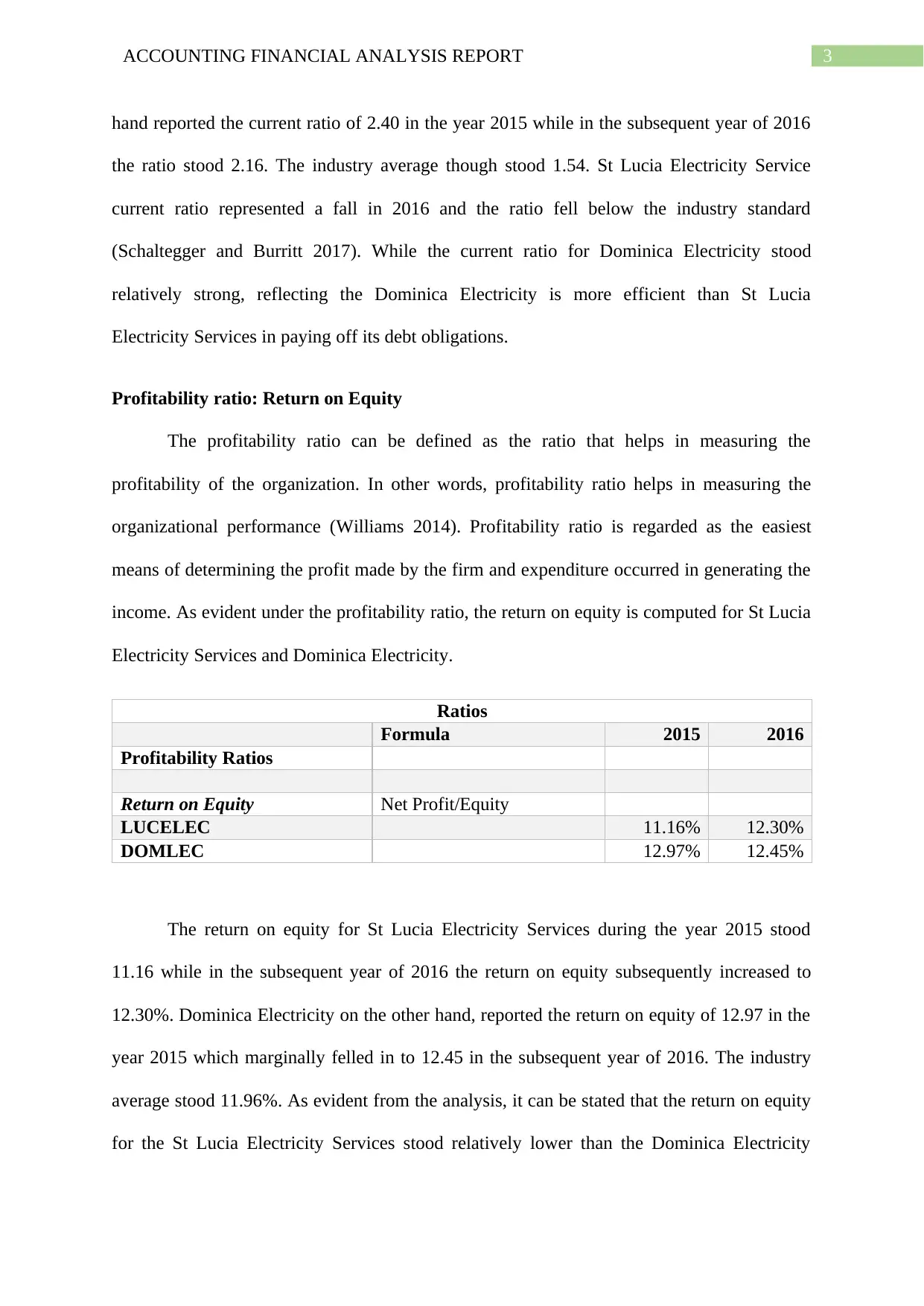
3ACCOUNTING FINANCIAL ANALYSIS REPORT
hand reported the current ratio of 2.40 in the year 2015 while in the subsequent year of 2016
the ratio stood 2.16. The industry average though stood 1.54. St Lucia Electricity Service
current ratio represented a fall in 2016 and the ratio fell below the industry standard
(Schaltegger and Burritt 2017). While the current ratio for Dominica Electricity stood
relatively strong, reflecting the Dominica Electricity is more efficient than St Lucia
Electricity Services in paying off its debt obligations.
Profitability ratio: Return on Equity
The profitability ratio can be defined as the ratio that helps in measuring the
profitability of the organization. In other words, profitability ratio helps in measuring the
organizational performance (Williams 2014). Profitability ratio is regarded as the easiest
means of determining the profit made by the firm and expenditure occurred in generating the
income. As evident under the profitability ratio, the return on equity is computed for St Lucia
Electricity Services and Dominica Electricity.
Ratios
Formula 2015 2016
Profitability Ratios
Return on Equity Net Profit/Equity
LUCELEC 11.16% 12.30%
DOMLEC 12.97% 12.45%
The return on equity for St Lucia Electricity Services during the year 2015 stood
11.16 while in the subsequent year of 2016 the return on equity subsequently increased to
12.30%. Dominica Electricity on the other hand, reported the return on equity of 12.97 in the
year 2015 which marginally felled in to 12.45 in the subsequent year of 2016. The industry
average stood 11.96%. As evident from the analysis, it can be stated that the return on equity
for the St Lucia Electricity Services stood relatively lower than the Dominica Electricity
hand reported the current ratio of 2.40 in the year 2015 while in the subsequent year of 2016
the ratio stood 2.16. The industry average though stood 1.54. St Lucia Electricity Service
current ratio represented a fall in 2016 and the ratio fell below the industry standard
(Schaltegger and Burritt 2017). While the current ratio for Dominica Electricity stood
relatively strong, reflecting the Dominica Electricity is more efficient than St Lucia
Electricity Services in paying off its debt obligations.
Profitability ratio: Return on Equity
The profitability ratio can be defined as the ratio that helps in measuring the
profitability of the organization. In other words, profitability ratio helps in measuring the
organizational performance (Williams 2014). Profitability ratio is regarded as the easiest
means of determining the profit made by the firm and expenditure occurred in generating the
income. As evident under the profitability ratio, the return on equity is computed for St Lucia
Electricity Services and Dominica Electricity.
Ratios
Formula 2015 2016
Profitability Ratios
Return on Equity Net Profit/Equity
LUCELEC 11.16% 12.30%
DOMLEC 12.97% 12.45%
The return on equity for St Lucia Electricity Services during the year 2015 stood
11.16 while in the subsequent year of 2016 the return on equity subsequently increased to
12.30%. Dominica Electricity on the other hand, reported the return on equity of 12.97 in the
year 2015 which marginally felled in to 12.45 in the subsequent year of 2016. The industry
average stood 11.96%. As evident from the analysis, it can be stated that the return on equity
for the St Lucia Electricity Services stood relatively lower than the Dominica Electricity
Paraphrase This Document
Need a fresh take? Get an instant paraphrase of this document with our AI Paraphraser
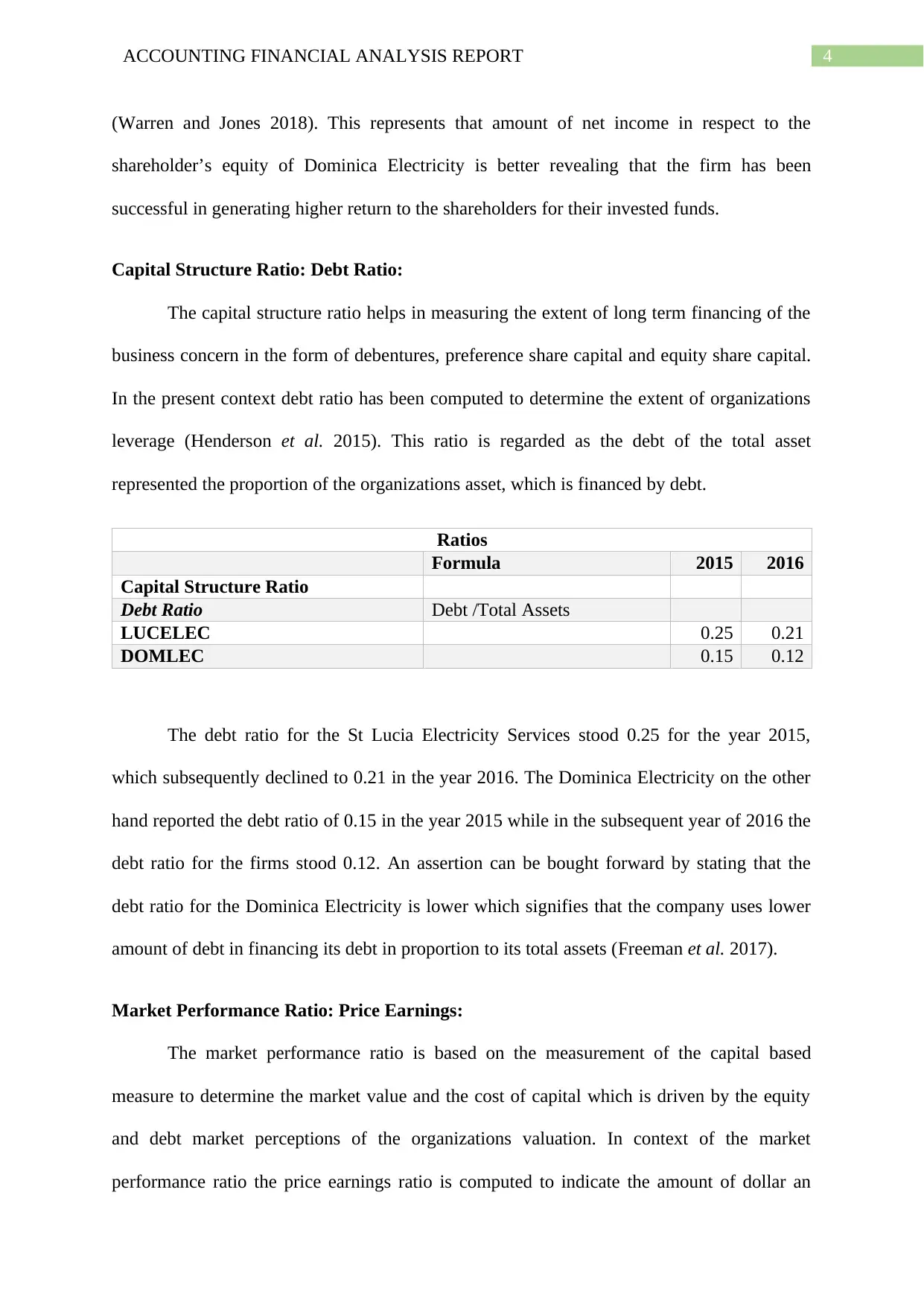
4ACCOUNTING FINANCIAL ANALYSIS REPORT
(Warren and Jones 2018). This represents that amount of net income in respect to the
shareholder’s equity of Dominica Electricity is better revealing that the firm has been
successful in generating higher return to the shareholders for their invested funds.
Capital Structure Ratio: Debt Ratio:
The capital structure ratio helps in measuring the extent of long term financing of the
business concern in the form of debentures, preference share capital and equity share capital.
In the present context debt ratio has been computed to determine the extent of organizations
leverage (Henderson et al. 2015). This ratio is regarded as the debt of the total asset
represented the proportion of the organizations asset, which is financed by debt.
Ratios
Formula 2015 2016
Capital Structure Ratio
Debt Ratio Debt /Total Assets
LUCELEC 0.25 0.21
DOMLEC 0.15 0.12
The debt ratio for the St Lucia Electricity Services stood 0.25 for the year 2015,
which subsequently declined to 0.21 in the year 2016. The Dominica Electricity on the other
hand reported the debt ratio of 0.15 in the year 2015 while in the subsequent year of 2016 the
debt ratio for the firms stood 0.12. An assertion can be bought forward by stating that the
debt ratio for the Dominica Electricity is lower which signifies that the company uses lower
amount of debt in financing its debt in proportion to its total assets (Freeman et al. 2017).
Market Performance Ratio: Price Earnings:
The market performance ratio is based on the measurement of the capital based
measure to determine the market value and the cost of capital which is driven by the equity
and debt market perceptions of the organizations valuation. In context of the market
performance ratio the price earnings ratio is computed to indicate the amount of dollar an
(Warren and Jones 2018). This represents that amount of net income in respect to the
shareholder’s equity of Dominica Electricity is better revealing that the firm has been
successful in generating higher return to the shareholders for their invested funds.
Capital Structure Ratio: Debt Ratio:
The capital structure ratio helps in measuring the extent of long term financing of the
business concern in the form of debentures, preference share capital and equity share capital.
In the present context debt ratio has been computed to determine the extent of organizations
leverage (Henderson et al. 2015). This ratio is regarded as the debt of the total asset
represented the proportion of the organizations asset, which is financed by debt.
Ratios
Formula 2015 2016
Capital Structure Ratio
Debt Ratio Debt /Total Assets
LUCELEC 0.25 0.21
DOMLEC 0.15 0.12
The debt ratio for the St Lucia Electricity Services stood 0.25 for the year 2015,
which subsequently declined to 0.21 in the year 2016. The Dominica Electricity on the other
hand reported the debt ratio of 0.15 in the year 2015 while in the subsequent year of 2016 the
debt ratio for the firms stood 0.12. An assertion can be bought forward by stating that the
debt ratio for the Dominica Electricity is lower which signifies that the company uses lower
amount of debt in financing its debt in proportion to its total assets (Freeman et al. 2017).
Market Performance Ratio: Price Earnings:
The market performance ratio is based on the measurement of the capital based
measure to determine the market value and the cost of capital which is driven by the equity
and debt market perceptions of the organizations valuation. In context of the market
performance ratio the price earnings ratio is computed to indicate the amount of dollar an

5ACCOUNTING FINANCIAL ANALYSIS REPORT
investor can anticipate to invest in the organization to determine the amount of dollar
received by the organizational earnings (Wang 2014). The price earnings ratio is at times
referred as the price multiple since it helps in showing what the investors are willing of pay
each for each dollar of earnings.
Ratios
Formula 2015 2016
Market performance Ratio
Price Earnings Ratio Price/Earnings
LUCELEC 15.9 16.2
DOMLEC 1.18 1.24
As evident from the computation, the price to earnings ratio for the St Lucia
Electricity Services stood 15.9 for the financial year of 2015 while in the subsequent year of
2016 the price to earnings ratio increased to 16.2. On the other hand, Dominica Electric
reported a price to earnings ratio of 1.18 in the financial year of 2015, which in the
subsequent year increased marginally to 1.24. Therefore, an assertion can be bought forward
the investors can anticipate higher amount of return from their investment in St Lucia
Electricity Services since the price to earnings ratio for the firm stood relatively higher than
the Dominica Electric (Hoyle, Schaefer and Doupnik 2015). The investors that are willing of
pay each for each dollar of earnings would receive a higher value dollar by the organizational
earnings.
Part 2: Share Evaluation
Computation of Share evaluation:
Particulars Amount
Risk Free Rate of Return A 2%
Market Risk Premium B 7%
Beta C 1.285
investor can anticipate to invest in the organization to determine the amount of dollar
received by the organizational earnings (Wang 2014). The price earnings ratio is at times
referred as the price multiple since it helps in showing what the investors are willing of pay
each for each dollar of earnings.
Ratios
Formula 2015 2016
Market performance Ratio
Price Earnings Ratio Price/Earnings
LUCELEC 15.9 16.2
DOMLEC 1.18 1.24
As evident from the computation, the price to earnings ratio for the St Lucia
Electricity Services stood 15.9 for the financial year of 2015 while in the subsequent year of
2016 the price to earnings ratio increased to 16.2. On the other hand, Dominica Electric
reported a price to earnings ratio of 1.18 in the financial year of 2015, which in the
subsequent year increased marginally to 1.24. Therefore, an assertion can be bought forward
the investors can anticipate higher amount of return from their investment in St Lucia
Electricity Services since the price to earnings ratio for the firm stood relatively higher than
the Dominica Electric (Hoyle, Schaefer and Doupnik 2015). The investors that are willing of
pay each for each dollar of earnings would receive a higher value dollar by the organizational
earnings.
Part 2: Share Evaluation
Computation of Share evaluation:
Particulars Amount
Risk Free Rate of Return A 2%
Market Risk Premium B 7%
Beta C 1.285
⊘ This is a preview!⊘
Do you want full access?
Subscribe today to unlock all pages.

Trusted by 1+ million students worldwide
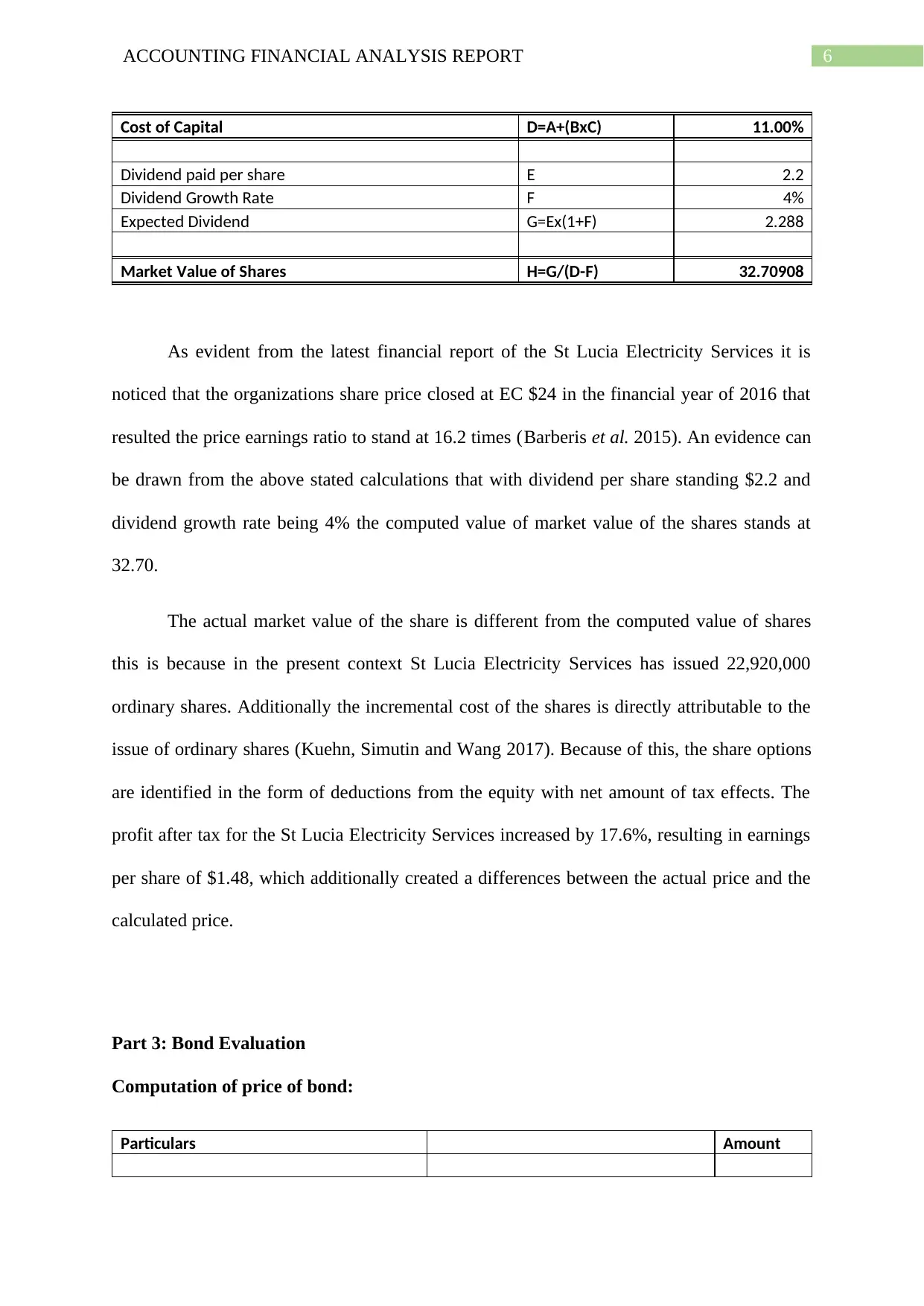
6ACCOUNTING FINANCIAL ANALYSIS REPORT
Cost of Capital D=A+(BxC) 11.00%
Dividend paid per share E 2.2
Dividend Growth Rate F 4%
Expected Dividend G=Ex(1+F) 2.288
Market Value of Shares H=G/(D-F) 32.70908
As evident from the latest financial report of the St Lucia Electricity Services it is
noticed that the organizations share price closed at EC $24 in the financial year of 2016 that
resulted the price earnings ratio to stand at 16.2 times (Barberis et al. 2015). An evidence can
be drawn from the above stated calculations that with dividend per share standing $2.2 and
dividend growth rate being 4% the computed value of market value of the shares stands at
32.70.
The actual market value of the share is different from the computed value of shares
this is because in the present context St Lucia Electricity Services has issued 22,920,000
ordinary shares. Additionally the incremental cost of the shares is directly attributable to the
issue of ordinary shares (Kuehn, Simutin and Wang 2017). Because of this, the share options
are identified in the form of deductions from the equity with net amount of tax effects. The
profit after tax for the St Lucia Electricity Services increased by 17.6%, resulting in earnings
per share of $1.48, which additionally created a differences between the actual price and the
calculated price.
Part 3: Bond Evaluation
Computation of price of bond:
Particulars Amount
Cost of Capital D=A+(BxC) 11.00%
Dividend paid per share E 2.2
Dividend Growth Rate F 4%
Expected Dividend G=Ex(1+F) 2.288
Market Value of Shares H=G/(D-F) 32.70908
As evident from the latest financial report of the St Lucia Electricity Services it is
noticed that the organizations share price closed at EC $24 in the financial year of 2016 that
resulted the price earnings ratio to stand at 16.2 times (Barberis et al. 2015). An evidence can
be drawn from the above stated calculations that with dividend per share standing $2.2 and
dividend growth rate being 4% the computed value of market value of the shares stands at
32.70.
The actual market value of the share is different from the computed value of shares
this is because in the present context St Lucia Electricity Services has issued 22,920,000
ordinary shares. Additionally the incremental cost of the shares is directly attributable to the
issue of ordinary shares (Kuehn, Simutin and Wang 2017). Because of this, the share options
are identified in the form of deductions from the equity with net amount of tax effects. The
profit after tax for the St Lucia Electricity Services increased by 17.6%, resulting in earnings
per share of $1.48, which additionally created a differences between the actual price and the
calculated price.
Part 3: Bond Evaluation
Computation of price of bond:
Particulars Amount
Paraphrase This Document
Need a fresh take? Get an instant paraphrase of this document with our AI Paraphraser
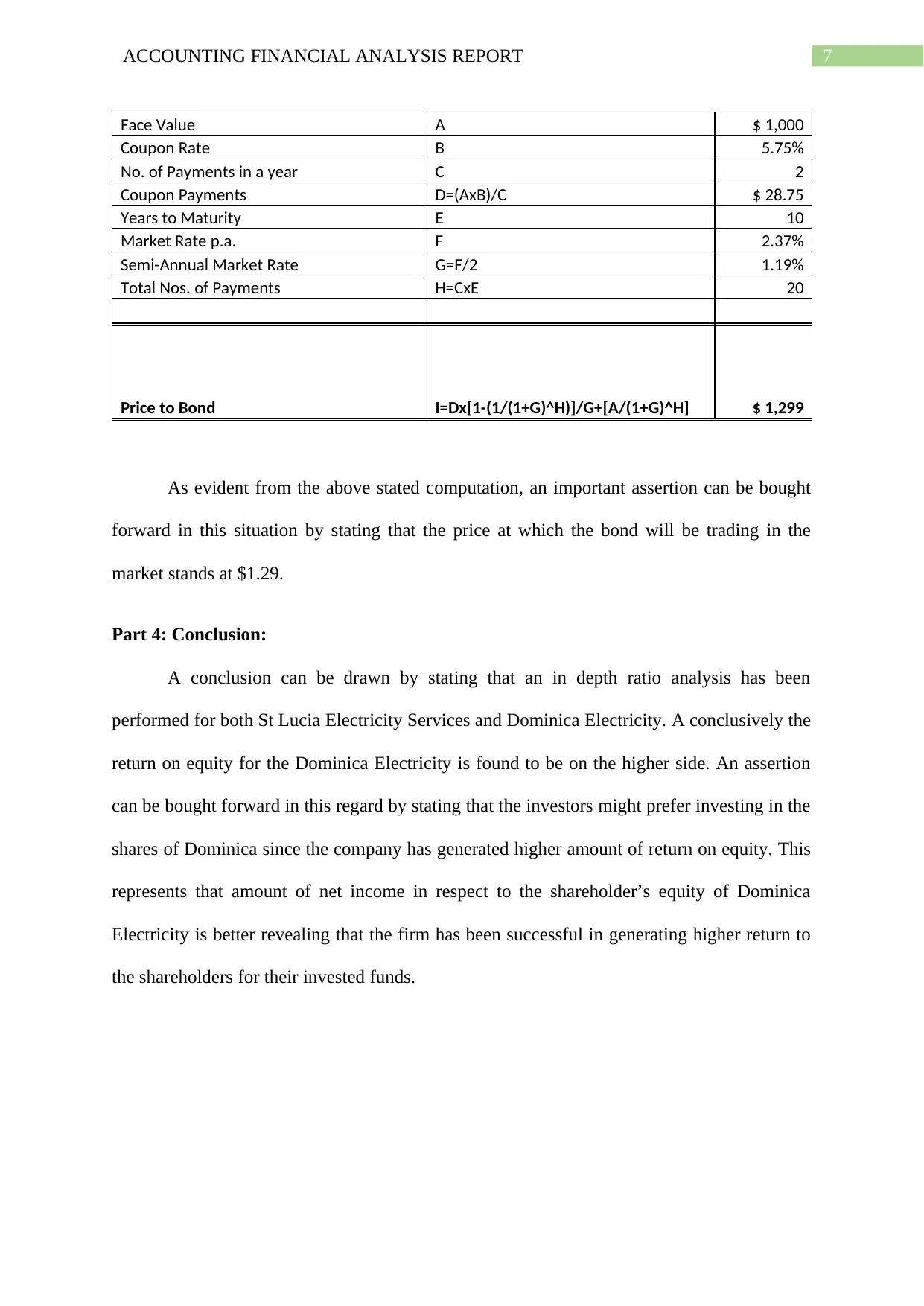
7ACCOUNTING FINANCIAL ANALYSIS REPORT
Face Value A $ 1,000
Coupon Rate B 5.75%
No. of Payments in a year C 2
Coupon Payments D=(AxB)/C $ 28.75
Years to Maturity E 10
Market Rate p.a. F 2.37%
Semi-Annual Market Rate G=F/2 1.19%
Total Nos. of Payments H=CxE 20
Price to Bond I=Dx[1-(1/(1+G)^H)]/G+[A/(1+G)^H] $ 1,299
As evident from the above stated computation, an important assertion can be bought
forward in this situation by stating that the price at which the bond will be trading in the
market stands at $1.29.
Part 4: Conclusion:
A conclusion can be drawn by stating that an in depth ratio analysis has been
performed for both St Lucia Electricity Services and Dominica Electricity. A conclusively the
return on equity for the Dominica Electricity is found to be on the higher side. An assertion
can be bought forward in this regard by stating that the investors might prefer investing in the
shares of Dominica since the company has generated higher amount of return on equity. This
represents that amount of net income in respect to the shareholder’s equity of Dominica
Electricity is better revealing that the firm has been successful in generating higher return to
the shareholders for their invested funds.
Face Value A $ 1,000
Coupon Rate B 5.75%
No. of Payments in a year C 2
Coupon Payments D=(AxB)/C $ 28.75
Years to Maturity E 10
Market Rate p.a. F 2.37%
Semi-Annual Market Rate G=F/2 1.19%
Total Nos. of Payments H=CxE 20
Price to Bond I=Dx[1-(1/(1+G)^H)]/G+[A/(1+G)^H] $ 1,299
As evident from the above stated computation, an important assertion can be bought
forward in this situation by stating that the price at which the bond will be trading in the
market stands at $1.29.
Part 4: Conclusion:
A conclusion can be drawn by stating that an in depth ratio analysis has been
performed for both St Lucia Electricity Services and Dominica Electricity. A conclusively the
return on equity for the Dominica Electricity is found to be on the higher side. An assertion
can be bought forward in this regard by stating that the investors might prefer investing in the
shares of Dominica since the company has generated higher amount of return on equity. This
represents that amount of net income in respect to the shareholder’s equity of Dominica
Electricity is better revealing that the firm has been successful in generating higher return to
the shareholders for their invested funds.
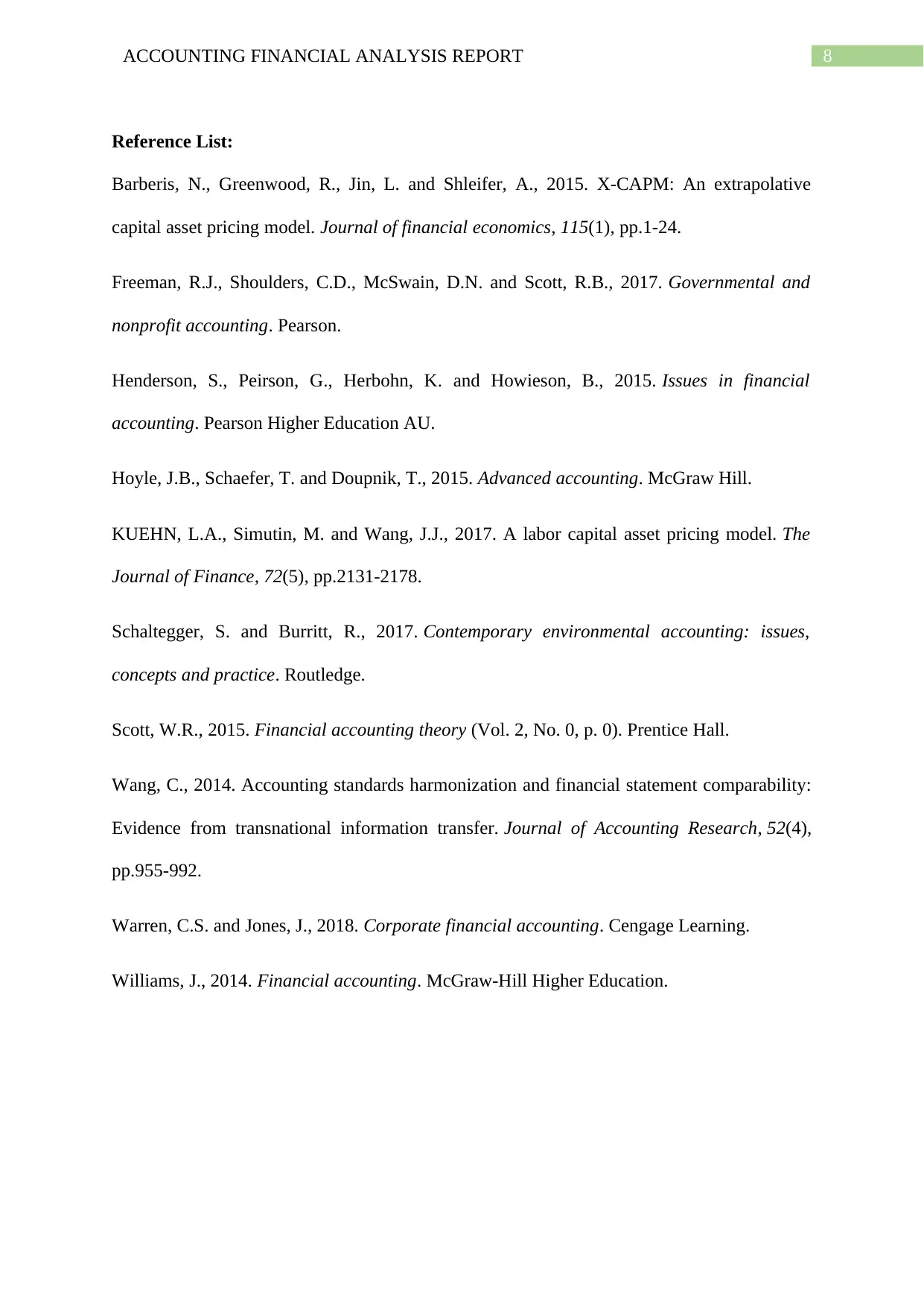
8ACCOUNTING FINANCIAL ANALYSIS REPORT
Reference List:
Barberis, N., Greenwood, R., Jin, L. and Shleifer, A., 2015. X-CAPM: An extrapolative
capital asset pricing model. Journal of financial economics, 115(1), pp.1-24.
Freeman, R.J., Shoulders, C.D., McSwain, D.N. and Scott, R.B., 2017. Governmental and
nonprofit accounting. Pearson.
Henderson, S., Peirson, G., Herbohn, K. and Howieson, B., 2015. Issues in financial
accounting. Pearson Higher Education AU.
Hoyle, J.B., Schaefer, T. and Doupnik, T., 2015. Advanced accounting. McGraw Hill.
KUEHN, L.A., Simutin, M. and Wang, J.J., 2017. A labor capital asset pricing model. The
Journal of Finance, 72(5), pp.2131-2178.
Schaltegger, S. and Burritt, R., 2017. Contemporary environmental accounting: issues,
concepts and practice. Routledge.
Scott, W.R., 2015. Financial accounting theory (Vol. 2, No. 0, p. 0). Prentice Hall.
Wang, C., 2014. Accounting standards harmonization and financial statement comparability:
Evidence from transnational information transfer. Journal of Accounting Research, 52(4),
pp.955-992.
Warren, C.S. and Jones, J., 2018. Corporate financial accounting. Cengage Learning.
Williams, J., 2014. Financial accounting. McGraw-Hill Higher Education.
Reference List:
Barberis, N., Greenwood, R., Jin, L. and Shleifer, A., 2015. X-CAPM: An extrapolative
capital asset pricing model. Journal of financial economics, 115(1), pp.1-24.
Freeman, R.J., Shoulders, C.D., McSwain, D.N. and Scott, R.B., 2017. Governmental and
nonprofit accounting. Pearson.
Henderson, S., Peirson, G., Herbohn, K. and Howieson, B., 2015. Issues in financial
accounting. Pearson Higher Education AU.
Hoyle, J.B., Schaefer, T. and Doupnik, T., 2015. Advanced accounting. McGraw Hill.
KUEHN, L.A., Simutin, M. and Wang, J.J., 2017. A labor capital asset pricing model. The
Journal of Finance, 72(5), pp.2131-2178.
Schaltegger, S. and Burritt, R., 2017. Contemporary environmental accounting: issues,
concepts and practice. Routledge.
Scott, W.R., 2015. Financial accounting theory (Vol. 2, No. 0, p. 0). Prentice Hall.
Wang, C., 2014. Accounting standards harmonization and financial statement comparability:
Evidence from transnational information transfer. Journal of Accounting Research, 52(4),
pp.955-992.
Warren, C.S. and Jones, J., 2018. Corporate financial accounting. Cengage Learning.
Williams, J., 2014. Financial accounting. McGraw-Hill Higher Education.
⊘ This is a preview!⊘
Do you want full access?
Subscribe today to unlock all pages.

Trusted by 1+ million students worldwide
1 out of 9